Product information on Distribution Unit (DU), with example of Distribution Unit (DU) label
The standard differs on different types of pallets depending on the content.
Only Standard pallet and Promotional Unit can provide a clear labelling of product information that applies to the entire pallet.
Standard pallet
A Distribution Unit (DU) containing the same product (same GTIN) with fixed count of Stock Keeping Units (SKU) and where labelling of unique product information on the Distribution Unit (DU) is possible.
It is recommended that a Standard pallet only contain Stock Keeping Units (SKU) with the same batch / lot number and shelf life date.
There are two different types of Standard pallet:
- Standard pallet with height 120 cm
- Standard pallet with height 60 cm (Standard Pallet – Low)
Standard pallet – Low is used for low-frequency products and for products with short shelf life.
A product can only be used on one type of Standard pallet, either 120 cm height or 60 cm height.
Standard pallet with height 120 cm
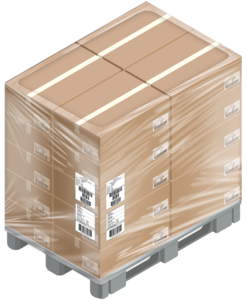
Standard pallet with height 60 cm (Standard pallet – Low)
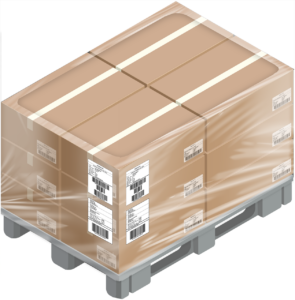
Standard pallet shall be labelled with product and transport information.
Since product information and transportation information are usually known at different times, the practical solution is to label the device with two different labels:
- Product information label (incl. SSCC)
- Label with transport information
Product information on the GS1 product label for Standard pallet
SSCC (License Plate)
Must be labelled with GS1-128 AI 00 on the GS1 Product label on each Standard pallet in human readable text and in the bar code. The SSCC provides a unique identification of each Distribution Unit (DU). Because of traceability a SSCC shall not be reused until after a minimum of 6 years.
The bar code containing the SSCC should be the lowest bar code on the label. It is recommended to have a bar code containing only the SSCC and no other AI’s.
GTIN – Global Trade Item Number
Standard pallet must be labelled with GTIN. This can be done in the following ways:
- Primarily, GTIN for the Stock Keeping Unit (SKU) should be used
- GS1-128 AI 02 must be used. The count of Stock Keeping Units (SKU) is also required on the Distribution Unit (DU) using GS1-128 AI 37
- The Distribution Unit’s (DU) own unique GTIN can also be used, using GS1-128 AI 01.
Product name
The product’s name must be written in human readable text on the Distribution Unit’s (DU) product label. Product name must be based on the text in the Norwegian grocery data pool – EPD database, and consists of product name, attributes, and product description. The product description labelled on the Distributions Unit (DU) must correspond to the text in the Despatch Advice and the invoice.
Batch / lot number.
GS1-128 AI 10 is generated by the manufacturer and used to track the product back to specific production series.
If all Stock Keeping Units (SKU) on the pallet have the same batch / lot number, this is indicated on the label in human readable text and bar code. If the pallet contains Stock Keeping Units (SKU) with different batch / lot numbers, batch / lot number is omitted on the label. However, all unique batch / lot numbers must be stated in the electronic Despatch Advice.
Shelf life information
GS1-128 AI 15 should be labelled on all Distribution Units (DU) that contain Consumer Unit (CU) with “Best before date” printed on them.
Alternatively, the expiration date (GS1-128 AI 17) may be used for shelf life marking.
Net weight (in grams)
GS1-128 AI 3103 shall be used for variable measure products. Net weight means weight of product excluding packaging (the same weight that is being invoiced).
Gross weight (in whole kg)
Shall be labelled in human readable text on each Distribution Unit (DU). Gross weight means weight of products, packaging and pallet (load carrier).
Max. top load (in whole kg)
Must be labelled in human readable text.
Distribution Units (DU) that can not be stacked (in transport or storing) are marked with: Cannot be stacked (Kan ikke stables).
Temperature requirements
shall be labelled in human readable text if the product has a temperature requirement.
Product labelling on Standard pallet
| Overview of product information that shall or may be labelled on Standard pallet: | ||||
| Information | Human readable text | GS1-128 (bar code) | AI | Format |
| SSCC (License Plate)1) | Must be labelled | Must be labelled | 00 | n2 + n18 |
| GTIN for the Distribution Unit (DU)2) | Can be labelled | Can be labelled | 01 | n2 + n14 |
| GTIN for the contained Stock Keeping Units (SKU) | Must be labelled | Must be labelled | 02 | n2 + n14 |
| Count of Stock Keeping Units (SKU) on the DU | Must be marked except when DU is defined as an SKU | Must be marked except when DU is defined as an SKU | 37 | n2 + n..8 |
| Product name | Must be labelled | Not labelled | ||
| Batch / lot number3) | Must be labelled | Must be labelled | 10 | n2 + an..20 |
| Best before date4) | Must be labelled if Consumer Unit (CU) has printed best before date | Must be labelled if Consumer Unit (CU) has printed best before date | 15 | n2 + n6 |
| Net weight | Must be labelled for products of variable measure | Must be labelled for products of variable measure | 3103 | n4 + n6 |
| Gross weight | Must be labelled | Can be labelled | 3300 | n4 + n6 |
| Max. top load | Must be labelled | Not labelled | ||
| Temperature requirements | Must be labelled if the product has temperature requirements | Not labelled | ||
| 1) SSCC shall be indicated on the product label but permitted on both labels provided that the same number is used. 2) Can be used in a case for a transitional period. 3) If Batch / Lot No. is omitted on the Stock Keeping Unit (SKU), or it is different Batch / Lot No. on the Stock Keeping Units (SKU) this should not be labelled on the Distribution Unit (DU). 4) Alternatively, the expiration date (GS1-128 AI 17) may be used for shelf life marking. |
||||
Example on the GS1 product label for Standard pallet
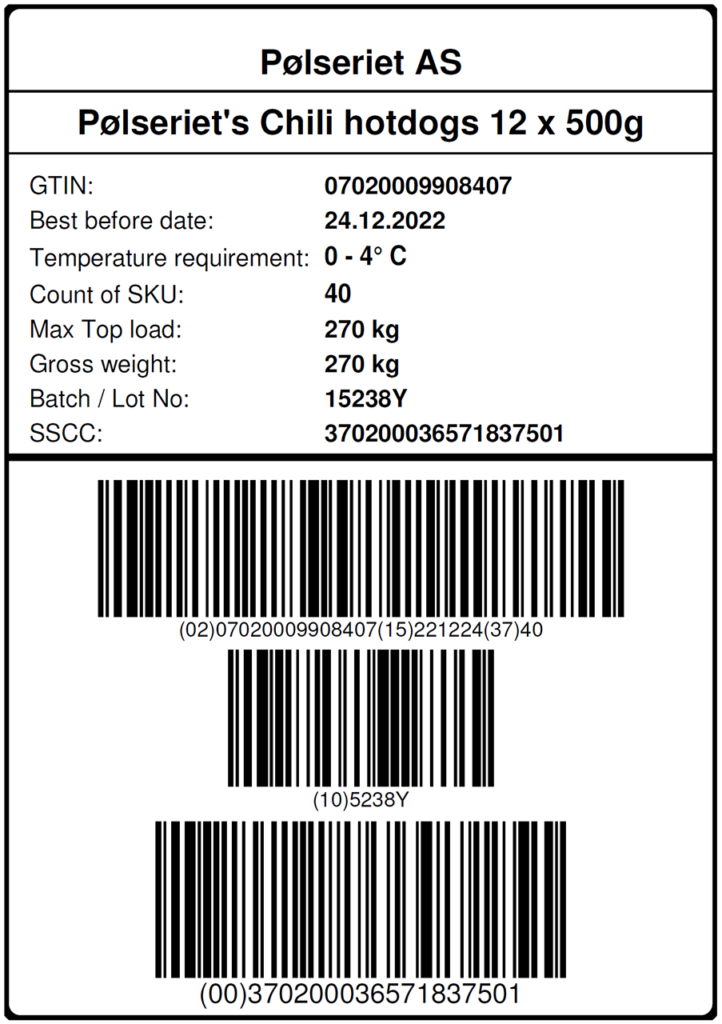
Promotional Unit
A Unit defined as a Stock Keeping Unit (SKU) containing a fixed number of Consumer Unit (CU), intended for display in stores.
Promotional Unit can be 1/1 pallet, 1/2 pallet or 1/3 pallet.
Each Promotional Unit has its own load carrier.
Promotional Unit consisting of 1/2 pallet or 1/3 pallet are placed on a slave pallet. This constitutes a transport unit.
If slave pallet is omitted, this must be agreed bilaterally. For example, for 1/2 pallets with good stability, they can be tied together and exclude the slave pallet. This allows for better use of the pallet by increasing the Promotional Unit, thus allowing more items on the pallet.
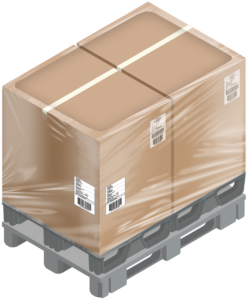
Promotional Units are labelled with two levels of SSCC:
- At the lowest level is labelled with Product label for Promotional Unit as a Stock Keeping Unit (SKU) with the addition of SSCC. The product label is labelled on each Promotional Unit.
- The whole Promotional Unit is labelled with Standard shipping label for the groceries sector. If the Promotional Unit is a 1/1 pallet, this is labelled as a Standard pallet.
Labelling of Promotional Units provides increased traceability in the value chain
Product information on the GS1 product label for Promotional Unit
SSCC (License Plate)
Must be labelled with GS1-128 AI 00 on the GS1 Product label on each Promotional Unit in human readable text and in the bar code. The SSCC provides a unique identification of each Distribution Unit (DU). Because of traceability a SSCC shall not be reused until after a minimum of 6 years.
The bar code containing the SSCC should be the lowest bar code on the label. It is recommended to have a bar code containing only the SSCC and no other AI’s.
GTIN – Global Trade Item Number
Promotional Unit must be labelled with GTIN. This can be done in the following ways:
- Primarily, GTIN for the Stock Keeping Unit (SKU) should be used
- GS1-128 AI 01 must be used
Product name
The product’s name must be written in human readable text on the Distribution Unit’s (DU) product label. Product name must be based on the text in the Norwegian grocery data pool – EPD database, and consists of product name, attributes, and product description. The product description labelled on the Distributions Unit (DU) must correspond to the text in the Despatch Advice and the invoice.
Batch / lot number
GS1-128 AI 10 is generated by the manufacturer and used to track the product back to specific production series.
If all Stock Keeping Units (SKU) on the Distribution Unit (DU) have the same batch / lot number, this is indicated on the label in plain text and bar code. If the Distribution Unit (DU) contains Stock Keeping Units (SKU) with different batch / lot numbers, batch / lot number is omitted on the label. However, all unique batch / lot numbers must be stated in the electronic Despatch Advice.
Shelf life information
GS1-128 AI 15 should be labelled on all Distribution Units (DU) that contain Consumer Unit (CU) with “Best before date” printed on them.
Consumer Unit (CU). Alternatively, the expiration date (GS1-128 AI 17) may be used for shelf life marking.
Net weight (in grams)
GS1-128 AI 3103 shall be used for variable measure Stock Keeping Units (SKU). Net weight means weight of product excluding packaging (the same weight that is being invoiced).
Gross weight (in whole kg)
shall be labelled in human readable text on each Distribution Unit (DU). Gross weight means weight of products, packaging and pallet (load carrier).
Max. top load (in whole kg)
must be labelled in human readable text.
Distribution Units (DU) that can not be stacked (in transport or storing) are marked with: Cannot be stacked.
Temperature requirements
shall be labelled in human readable text if the product has a temperature requirement.
Product labelling on Promotional Unit
| Overview of labelling of product information that may or may not be labelled on Promotional Unit: | ||||
| Information | Human readable text | GS1-128 (bar code) | AI | Format |
| SSCC (License Plate) | Must be labelled | Must be labelled | 00 | n2 + n18 |
| GTIN for Stock Keeping Unit (SKU) | Must be labelled | Must be labelled | 01 | n2 + n14 |
| Product name | Must be labelled | Not labelled | ||
| Batch / lot number1) | Must be labelled | Must be labelled | 10 | n2 + an..20 |
| Best before date2) | Must be labelled if Consumer Unit (CU) has printed best before date | Must be labelled if Consumer Unit (CU) has printed best before date | 15 | n2 + n6 |
| Temperature requirements | Must be labelled if the product has temperature requirements | Not labelled | ||
| Supplier’s item number | Must be labelled | Not labelled | ||
| 1) If Batch / Lot No. is omitted on the Stock Keeping Unit (SKU), or it is different Batch / Lot No. on the Stock Keeping Units (SKU) this should not be labelled on the Distribution Unit (DU). 2) Alternatively, the expiration date (GS1-128 AI 17) may be used for shelf life marking. |
||||
Example of Stock Keeping Unit (SKU) label with SSCC for Promotional Unit
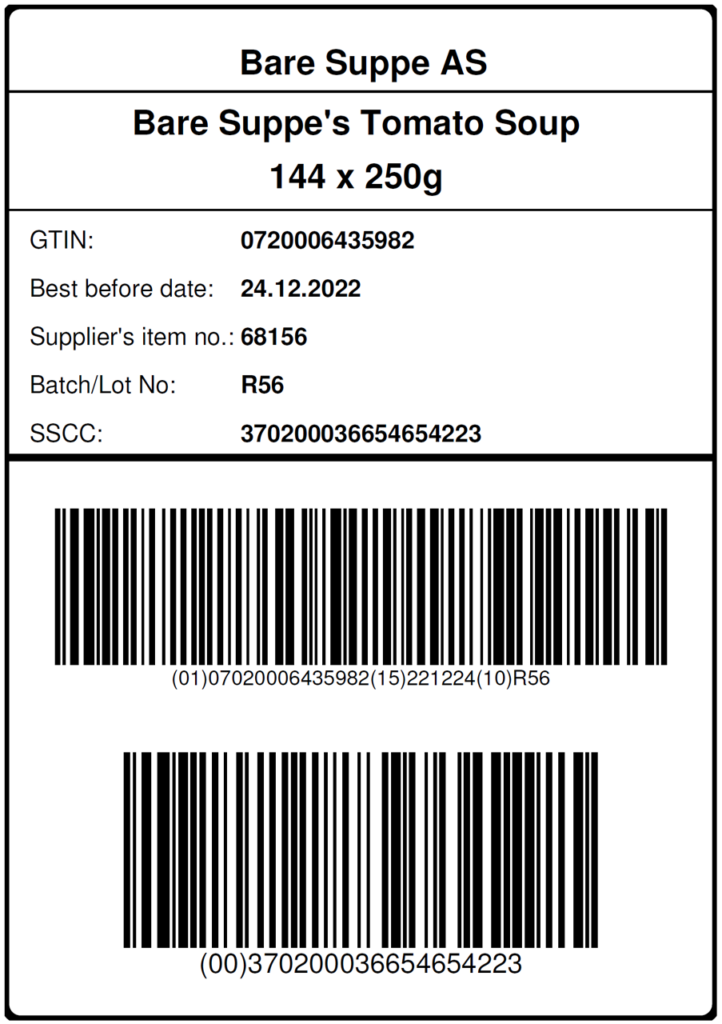
Units where product information can not be entered on their own label
Mixed pallet
Two variants of Mixed pallets are described; with and without intermediate pallet.
On Mixed pallet it is not possible to enter product information on its own label.
Mixed pallet without intermediate pallet:
Pallet consisting of several different products.
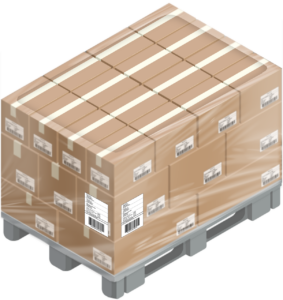
Mixed pallet with intermediate pallet:
Pallet consisting of several different products, where each product is stacked in one or more layers, and where each different product is separated by an intermediate pallet.
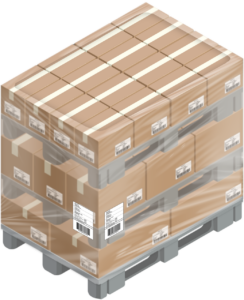
The choice of type of mixed pallet depends, among other things, on handling costs, transport / environmental costs and storage technology and must be agreed bilaterally between the parties.
Packaging and stability of the Stock Keeping Unit (SKU) must be considered when choosing type of a Mixed pallet.
If intermediate pallet(s) are used, it shall always be ordered the amount of Stock Keeping Units (SKU) to complete a layer.
Mixed pallet (both with and without intermediate pallet) is labelled with Standard shipping label for Norwegian grocery sector.
Customer packed pallet
When a supplier assembles products for delivery to the final recipient, the products are packaged and labelled with SSCC at two packaging levels.
Customer packed units are labelled for delivery to the end-user and the Distribution Unit (DU) is labelled for delivery to the transit warehouse.
On Customer packed units it is not possible to enter product information on the Distribution Unit (DU) label.
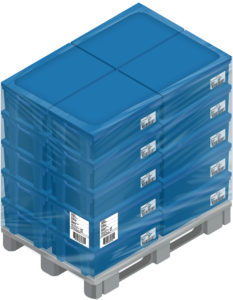
A customer-packed pallet can be Customer packed unit – multiple route, multiple customers, Customer packed unit – single route, multiple customers, or Customer packed unit – single customer.
- Customer packed unit – multiple route, multiple customers is a unit of products for two or more end recipients that will be split in transit storage.
- Customer packed unit – single route, multiple customer is a unit of products for two or more end recipients on the same route or transport.
- Customer packed unit – single customer is a unit of products that are intended for only one end recipient.
This Customer packed units does not need to have its own load carrier and is being loaded on a standardized transport unit (for example, an EUR pallet).
Customer packed unit – multiple route, multiple customers and Customer packed unit – single route, multiple customer is stacked in columns per. end receiver.
Customer packed unit – multiple route, multiple customers is split after products receipt in the transit warehouse, and the individual Customer packed unit is forwarded to the final recipient. A prerequisite is that all Customer packed units located on one Distribution Unit (DU) are destined for the same transit warehouse.
